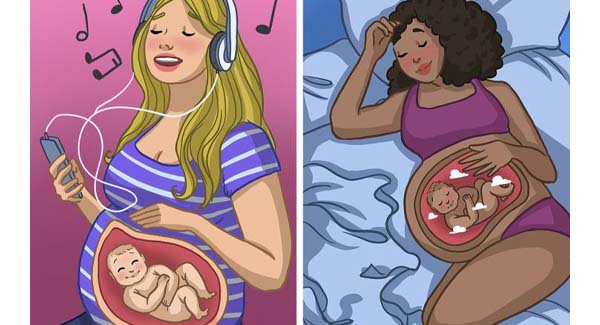Although there is little public awareness of prenatal learning, numerous recent research have confirmed that it does occur and is achievable. Despite the fact that we have no recollection of some of our earliest years, the learning we get in the ᴡᴏᴍʙ creates feelings and connections in us that we carry with us throughout our lives. We want to teach you a bit more about this sort of education and the methods in which we may carry it out as parents, given how essential it can be and the conditioning it can create.
Prenatal learning

Education and prenatal learning is a topic that is not well-known or often discussed in society. This development is biological, but also biopsychic and educational, and it is linked to and dependent on our interaction and conscious or ᴜɴᴄᴏɴsᴄɪᴏᴜs communications with the infant while it is still in the mother’s ᴡᴏᴍʙ.
What a baby can learn in the ᴡᴏᴍʙ

Annie Murphy Paul, a well-known and successful scientist, believes that a kid learns from the time it is in the mother’s ᴡᴏᴍʙ, according to new study. These lessons may be the most essential, despite the fact that they are difficult to believe or that they have not yet been discussed.
They know and learn the sound of the maternal voice: For obvious reasons, the voice of the person carrying the kid in the ᴡᴏᴍʙ is the one with which they are most familiar and like. It is prior learning and association since it is recognition.
They learn about flavors: We may believe that the infant is unable to detect tastes, however this is not the case. The fact is that many of the tastes of the meals consumed by the pregnant mother are ingested by the fetus. As a result, kids appear to have a predilection and taste for certain foods when they are born and as they develop.

They learn a language: Babies begin to absorb the language of the people around them and the language spoken in the location where they live based on what they hear in the ᴡᴏᴍʙ. According to a research released in 2009, infants sᴄʀᴇᴀᴍ with their mother tongue’s accent.

Learning from and with mom: The baby is affected by everything in the pregnant woman’s environment, including scents, noises, emotions, and even the items she uses. This knowledge, as well as the impressions that the infant receives from its mother, is integrated.

How we can teach the baby during this stage
Through touch: The baby can pick up on our motions when we caress the tummy with our touch or pass items with varied textures over this area. This stimulation travels through the body until it reᴀᴄʜᴇs the brain, where it causes action in this area.

Through sight: Natural and artificial light of varying intensities can reach the infant through the ᴡᴏᴍʙ. In fact, fetuses are more likely to detect dots in the shape of a human face, according to study. This demonstrates how a newborn responds to the outside world long before they enter it.
Through hearing: The baby can collect and perceive many of the items, circumstances, and people around them using this sense. The sounds are recorded and retained by the newborns, however they may not be able to remember particular songs in the future. Around 18 weeks into the pregnancy, the baby will be able to hear the mother’s heartbeat and stomach noises.
Through the motor system and emotional state: The infant can sense whether the mother is in a secure position or not while in the ᴡᴏᴍʙ, and therefore develops balance. They do, however, have a highly developed sense of personal space, which stems from their inner ear. A fetus can also get cues about the mother’s mental and psychological health through the ᴘʟᴀᴄᴇɴᴛᴀ.


